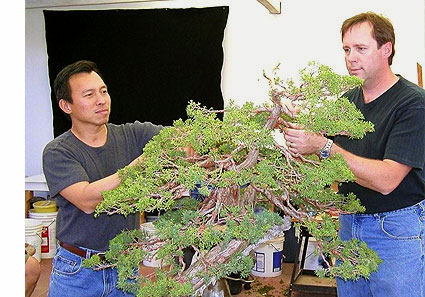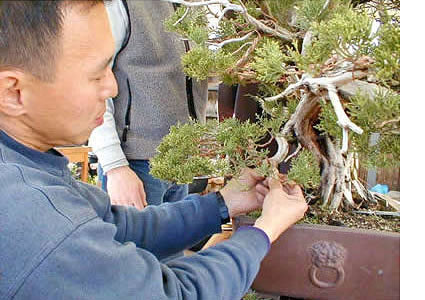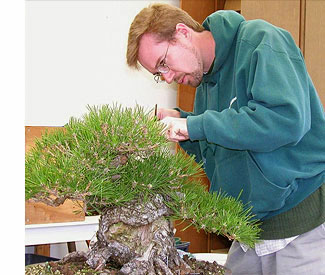|
|
|
|
|||||||||||
 |
|||||||||||||
 |
 |
 |
 |
||||||||||
|
|
|||||||||||||
 |
 |
||||||||||||
 |
I first met Boon Manakitivipart some years ago at a bonsai convention. He was energetic and animated, and sported a day-bag slung over one shoulder. I recall telling him I had read some articles he had written, and was watching his rising career with interest. Back then I had no idea this man would eventually change my orientation in bonsai, and become my sensei. The 2000 Golden State Convention in Oakland, CA was the catalytic event that led to extended study in Boon's bonsai yard. It was a wonderful convention in many respects, with one of the best exhibits I'd ever seen. In particular, I was struck by the refinement of several trees. I returned again and again to those trees, studying them closely. Back in the vendor area I struck up a conversation with Boon, and later he gave me an informal tour of the exhibit trees. While wandering through the exhibit discussing trees I realized that it was Boon's, his students' or his clients' trees that I had been admiring earlier. Many of these, in fact, were in the top 100 of the Japan Airlines (JAL) World Bonsai Contest, 2000. Well, I was impressed, and I had the long drive back to Arizona to develop that impression into a full-fledged desire to study with him. But would there be an opportunity to do so? The 2000 Golden State Convention in Oakland, CA was the catalytic event that led to extended study in Boon's bonsai yard. It was a wonderful convention in many respects, with one of the best exhibits I'd ever seen. In particular, I was struck by the refinement of several trees. I returned again and again to those trees, studying them closely. Back in the vendor area I struck up a conversation with Boon, and later he gave me an informal tour of the exhibit trees. While wandering through the exhibit discussing trees I realized that it was Boon's, his students' or his clients' trees that I had been admiring earlier. Many of these, in fact, were in the top 100 of the Japan Airlines (JAL) World Bonsai Contest, 2000. Well, I was impressed, and I had the long drive back to Arizona to develop that impression into a full-fledged desire to study with him. But would there be an opportunity to do so?The answer came quickly. Only several days later I was looking at Boon's website and discovered that he was offering an extended, in-depth program called the 'Bonsai Intensive'. A month later I was back in California, engaged in the pilot session of the Bonsai Intensive. It proved to be a singular awakening. The Bonsai Intensive is an alternative to the workshop. There are several things that make it unique—students work on old, established trees; the work is in depth, intricate in detail and extended over several days; and often the same trees are returned to in later sessions for follow up. The value of this framework is simply that it traces the developmental progression of many species from initial styling through to refinement work. Bonsai Intensive sessions are three days long, have a maximum of five people per session, and are offered four times a year. Certificates are awarded for each of the twelve sessions, and there is one final 'completion' certificate at the end of three years' study. The days are long and focused. At 8:30 am the work on trees begins, with one hour off for lunch, then back to work until 6:00 pm. After dinner one returns for two hours of study to go over applicable written material. Sometimes the day is a bit longer. One day last January I worked well past dark, for almost 10 hours, to finish styling a California juniper. Then a few hours were added in the evening to review juniper refinement techniques—a long day indeed!  On being accepted into the program, I was asked what species of trees made up my collection, and what my short term goals were. Where it could, the teaching would be tailored to fit my needs. On being accepted into the program, I was asked what species of trees made up my collection, and what my short term goals were. Where it could, the teaching would be tailored to fit my needs.While some parts of the course are tailored, other parts, such as repotting, are not. Each Intensive student learns that careful, correct repotting sets the stage for all future work. Because many of the bonsai methods used in Japan are counterintuitive, Boon asks that his students initially follow his advice without changing procedure or substituting. This is critical. All steps are very closely linked, from beginning root-work to later foliage refinement. While following advice to the letter is difficult for many of us, it is essential to suppress old bonsai habits in order to learn what Boon has to offer. I was surprised to find that many of the methods I'd always taken for granted were simply ineffective, or counterproductive. Boon is a conduit for information that simply explodes some western myths we have about cultivating bonsai. In the evenings we often studied directly from Kokufu exhibition books. Boon commented in detail about these Japanese trees. He pointed out various masters' subtle yet detectable style, the structure of a 'good' tree, and even how to properly clean an antique pot.  Students in the Intensive work on trees of a quality not often seen in the United States. As said earlier, students don't bring their own trees, they work on Boon's. They repot his trees, do first time styling, foliage cleanup, detail wiring, routine maintenance, advanced bending, ramification work, and prepping trees for exhibition. One tree I helped repot was a JAL award winner in 2000. Another tree which I styled was headed for that same competition in a year or two. Students in the Intensive work on trees of a quality not often seen in the United States. As said earlier, students don't bring their own trees, they work on Boon's. They repot his trees, do first time styling, foliage cleanup, detail wiring, routine maintenance, advanced bending, ramification work, and prepping trees for exhibition. One tree I helped repot was a JAL award winner in 2000. Another tree which I styled was headed for that same competition in a year or two.It's hard to describe how this exposure to superb trees changes one's attitude and approach. Studying on already highly refined trees gives one the tools to address trees at home with greater latitude and ability, and to 'see' where one is headed. Some may return home with the conviction to upgrade stock with better material, or they may simply apply new information to bring the trees 'online' to another level. I did some of both. I also discovered that working on my own trees after returning home crystallized the lessons from Boon's yard. There is an element of barter in the Intensive: The teaching balances the student's work on bonsai. Sometimes the student 'work' is simply being an extra hand. One day we put a 60 degree bend in a large Sierra juniper trunk. The trunk was as big around as my forearm. In this instance, I was both student and assistant in a complicated job that was difficult for just one. A personal note: Because of Boon's deep and continued study in Japan, his Intensive program in essence offers the tools of the contemporary Japanese tradition. Working with Boon gave me ample time to ponder the benefits of the old-world way of learning, from master to apprentice. The Bonsai Intensive is not a master/apprentice program, yet some key elements are retained. Recognizing something different was expected of me made the experience more fruitful, and indeed offered a revelation that I wish to share. Michael Hagedorn has completed his apprenticeship with Shinji Suzuki in Obuse, Japan. Mike is now working as a bonsai professional in the USA. You may visit his website at www.crataegus.com. |
||||||||||||
|
|
|||||||||||||
|
|
|
|
|
|
|||||||||
 Since taking part in the Bonsai Intensive I have come to view bonsai as a highly technical activity. It is grounded in technical knowledge, like architecture or medicine. The better we know these fundamentals, the better we can use them to do something creative. I started in bonsai with the notion that it is primarily a creative endeavor. It is not. It is primarily technical. The longer we retain the notion it is firstly creative, the greater the chances we will neglect to study its details. When that happens, we are using crooked arrows to shoot at moving targets.
Since taking part in the Bonsai Intensive I have come to view bonsai as a highly technical activity. It is grounded in technical knowledge, like architecture or medicine. The better we know these fundamentals, the better we can use them to do something creative. I started in bonsai with the notion that it is primarily a creative endeavor. It is not. It is primarily technical. The longer we retain the notion it is firstly creative, the greater the chances we will neglect to study its details. When that happens, we are using crooked arrows to shoot at moving targets.